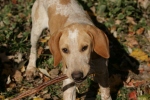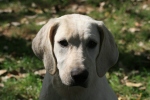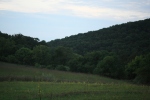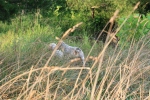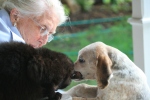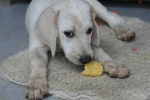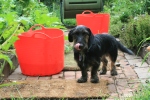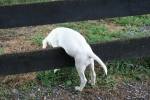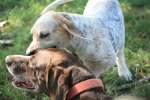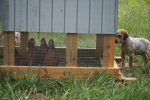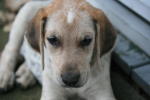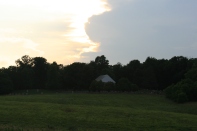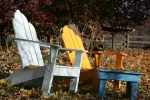 November, 2013: Kinetin and Kiwi
November, 2013: Kinetin and Kiwi
It’s almost Thanksgiving. It seemed summer didn’t arrive until that hot spell in September. August was like May. October felt like August. I’m all mixed up especially since this year’s puppies came late to Green Spring Farm and have already returned home. Kinetin and Kiwi were from a late litter born to the Potomac Hunt and drafted, just like members of a sports team, to Blue Ridge. I picked them up as ten-week old pups in early September. Kinetin (rhymes with…nothing…but the “i” is long and the “e” is silent) is the dog and Kiwi is the bitch.
I had prepared the fern garden early, fencing it with chicken wire to keep the puppies out, but Jeff was back to paint, not the porch, but the whole house. Jeff loves dogs and he assured me that the puppies were “no problem.” The little pests stole a paint brush and a tube of calk from his tool chest and he couldn’t keep them out of his sandpaper. They weren’t too terrible until the day when Jeff, high up on his extension ladder, felt a tug on the rope that collapses the ladder. It had happened once before on another job, he told me later: the rope somehow malfunctioned, the ladder collapsed and he fell two stories. This time, when he looked down, Kinetin had the rope in his mouth and was headed around the corner of the house with it. “Whoa, boy,” Jeff called down, easing himself from a second-story window frame he’d been painting. This is the sort of situation where you don’t really want to frighten the thing you really want to frighten. I was reminded of the time, over twenty years ago, when our middle son, Duncan, was two and decided to climb a ladder to the porch roof where his dad was repairing a window sash. Bill had his back to the ladder when he heard Duncan say “Da Da,” and turned to see him teetering on the edge of the gutter with his arms extended. You want to scream. You want to lunge. Your face wants to distort in fright, but you must repress these impulses and speak ever so calmly to the puppy with your life in its mouth.
They weren’t too terrible until the day when Jeff, high up on his extension ladder, felt a tug on the rope that collapses the ladder. It had happened once before on another job, he told me later: the rope somehow malfunctioned, the ladder collapsed and he fell two stories. This time, when he looked down, Kinetin had the rope in his mouth and was headed around the corner of the house with it. “Whoa, boy,” Jeff called down, easing himself from a second-story window frame he’d been painting. This is the sort of situation where you don’t really want to frighten the thing you really want to frighten. I was reminded of the time, over twenty years ago, when our middle son, Duncan, was two and decided to climb a ladder to the porch roof where his dad was repairing a window sash. Bill had his back to the ladder when he heard Duncan say “Da Da,” and turned to see him teetering on the edge of the gutter with his arms extended. You want to scream. You want to lunge. Your face wants to distort in fright, but you must repress these impulses and speak ever so calmly to the puppy with your life in its mouth.
“Oh God,” I said, when Jeff explained what Kinetin had intended.
“It’s ok,” Jeff said. “Nothing happened.”
Yes, but I pictured Jeff, flat on the hard September ground, with his back broken, Kinetin licking his face.
They were sweet and surprisingly care-free, these pups. They didn’t destroy too much. Food was their biggest incentive, their one and only driving force. They dragged half a deer carcass up from the pond soon after bow season started. The deer must have been wounded and had found its way to our pond to die. The puppies were thankful. No, Kinetin and Kiwi were easy puppies, except that the world didn’t seem to hold enough food for the two of them.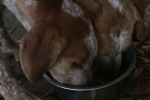
They didn’t particularly like puppy chow, even when I added milk. They soon graduated to real dog food and proceeded to eat us out of house and home. I bought two 50 pound bags of dog food a week. Of course that was for our dogs too, but the pups were bottomless and they didn’t seem to be putting on weight. I finally figured out that they had tape worms and, after treatment, they fattened up fast. Still, they wanted more and more food. Every time I  went outside to check on them, they’d emptied the food bowl and were sniffing around for more. I decided to get them some beef bones to occupy their time between meals.
went outside to check on them, they’d emptied the food bowl and were sniffing around for more. I decided to get them some beef bones to occupy their time between meals.
I remembered that Southern States carried cooked beef joints, so off I went to buy a few. Our friend Carol has worked at Southern States for as many years as we’ve lived here, going on thirty now. Carol often helps the Frederick County animal shelter by fostering pregnant bitches and finding homes for the pups. We got Spud from Carol fifteen years ago. Spud died two weeks ago of lung cancer. Good old Spud. We miss him.
 When I went to pick up a knuckle or two for the hound puppies, I saw another product on the dog-snack shelf I’d never seen. “Bully Sticks.” They looked to me like some sort of long tendon and I pictured it attached from a bull’s massive hip bone to his knee. They looked manageable and tasty and they weren’t too expensive so I bought a package of ten “12-inch Bully Sticks.”
When I went to pick up a knuckle or two for the hound puppies, I saw another product on the dog-snack shelf I’d never seen. “Bully Sticks.” They looked to me like some sort of long tendon and I pictured it attached from a bull’s massive hip bone to his knee. They looked manageable and tasty and they weren’t too expensive so I bought a package of ten “12-inch Bully Sticks.”
Boy, they were a hit. Kinetin and Kiwi loved them, and so did Ashie and Jake. All four dogs lay around the back yard blissfully chewing, chewing, chewing. Each fresh stick lasted a good hour and made for some great games of chase. They didn’t exactly melt in the dogs’ mouths, but they crunched nicely and seemed to sort of dissolve with pressure. The only down side, so far as I could tell, was the resultant horribly bad breath the dogs acquired. They were happy, so I didn’t complain.
“Did you see the new treats I got the puppies?” I asked Bill. “They love them. They’re called ‘Bully Sticks.’ ”
“What’s a Bully Stick?”
“I don’t know. Some sort of ‘beef byproduct.’ ”
A few days went by. The dogs, though beset with halitosis, were content. When it came time to take the puppies to the barn to bed them down each evening, normally a difficult journey, I’d grab a Bully Stick, wave it in front of their faces and they’d follow me happily. The sticks were gone within a week and I went back for more.
Then came the evening when Bill said, “Martha.” (He calls me by my given name when he needs to correct me, or remind me, or admonish me, or call my attention to some glaringly obvious thing I’ve overlooked. I can imagine George Washington using the same tone with his Mob-capped wife.) “Do you know what those things are?” he asked.
“What?”
His lips curled slightly, slyly, wryly. “What do they look like?”
“I don’t know. Some sort of tendon?”
“Martha…”
“What?”
“They’re bull penises. A ‘Bully Stick’ is a bull’s penis.”
“No…”
“Yep.”
Well, you can imagine that the conversation went down hill from there. They come in six, nine and twelve-inch lengths. . . yes girls, here’s your chance to make a fair comparison . . . the source of the world’s worst cases of halitosis . . . tasty and expeditious . . . when you’re fed up, feed it to the dog . . .
Come to find out, they’re not too safe. Fox News reports that Bully Sticks have made a few dogs sick, and people too. Also called pizzle sticks—a word derived from ‘low German’ (do high Germans avoid it?) meaning, according to Webster’s, “an animal’s penis” —they are fattening too, packing a whopping 22 calories per inch (insert bad bull-penis joke), or 224 calories per big one or thirty percent of a large dog’s daily calorie requirement. Fat dogs should avoid them, but no wonder the puppies found them so satisfying. Scientists who studied a “small” sample (bad joke prompt) found that they contain Clostridium difficile, methicillin-resistant Staphylococcus aureus and e. coli. Researchers recommended washing your hands after handling. (No joke.)
Time told that nobody was harmed. I let the dogs finish the package. I washed my hands. Often.
With a nick-nack-padywack, I threw the dogs a nice, long, satisfying pizzle.

